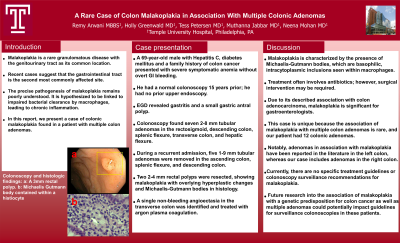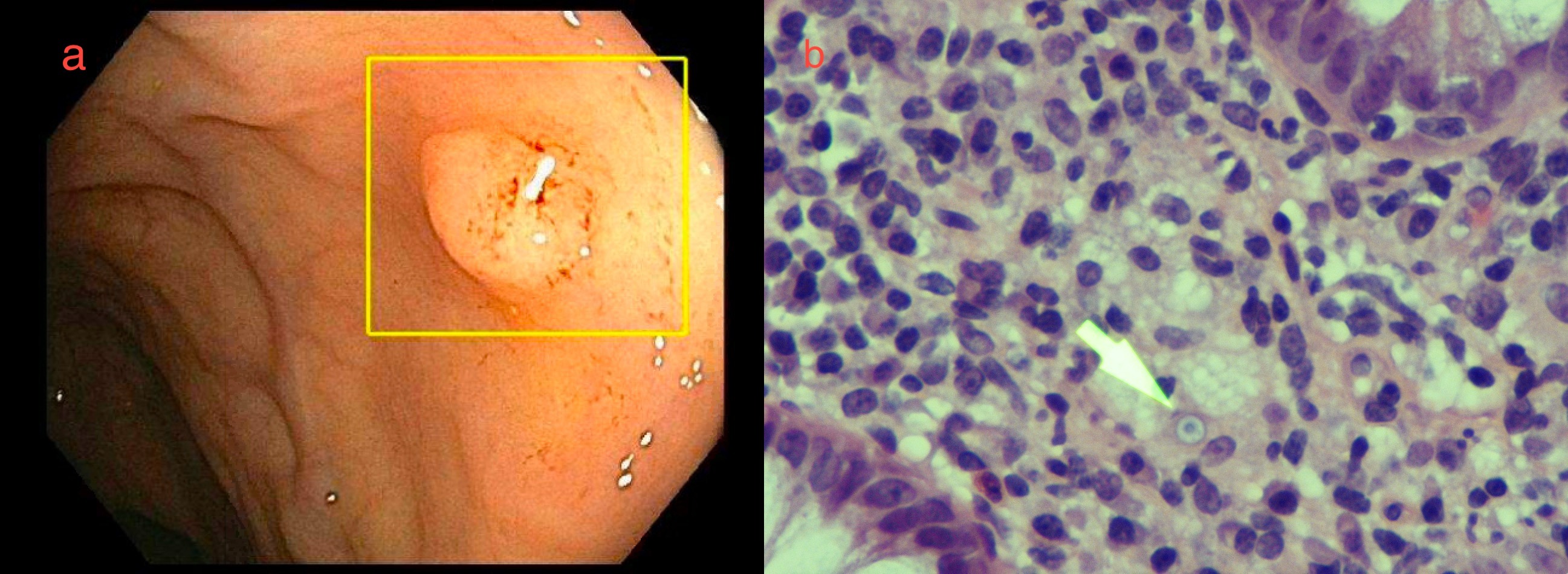Tuesday Poster Session
Category: Colon
P3162 - A Rare Case of Colon Malakoplakia in Association With Multiple Colonic Adenomas
Tuesday, October 24, 2023
10:30 AM - 4:00 PM PT
Location: Exhibit Hall

Has Audio

Remy Arwani, MBBCh
Temple University Hospital
Philadelphia, Pennsylvania
Presenting Author(s)
Remy Arwani, MBBCh, Holly Greenwald, MD, Tess Peterson, MD, Muthanna Jabbar, MD, Neena Mohan, MD
Temple University Hospital, Philadelphia, PA
Introduction: Malakoplakia is a rare granulomatous disease that commonly affects the genitourinary tract, however the gastrointestinal tract is the second most common location. Its pathogenesis is poorly understood but hypothesized to be related to impaired bacterial clearance by macrophages resulting in chronic inflammation. We present a case of colonic malakoplakia identified in a patient with findings of numerous colon adenomas.
Case Description/Methods: A 69 year old male with a history of Hepatitis C, diabetes mellitus and family history of colon cancer presented with new severe symptomatic anemia without overt GI blood loss. He reported having a normal colonoscopy 15 years prior, with no prior upper endoscopy. He underwent EGD/colonoscopy, with the endoscopy showing gastritis and small gastric antral polyp. The colonoscopy had fair prep, and seven 2-8 mm tubular adenomas were resected in the rectosigmoid, descending colon, splenic flexure, transverse colon and hepatic flexure. During a recurrent admission, five 1-9 mm tubular adenomas were removed in the ascending colon, splenic flexure, and descending colon. Two 2-4 mm rectal polyps were resected, with pathology showing malakoplakia with overlying hyperplastic changes, histology showed Michaelis-Gutmann bodies contained within histiocytes. A single nonbleeding angioectasia in the transverse colon was also identified on both colonoscopies and treated during the second colonoscopy with argon plasma coagulation.
Discussion: Malakoplakia is characterized by the presence of Michaelis-Gutmann bodies, which are basophilic, intracytoplasmic inclusions seen within macrophages. Treatment often involves antibiotics; however surgical intervention may be required. Because of its described association with colon adenocarcinoma, malakoplakia is an important entity for gastroenterologists. This case is unique as the association of malakoplakia with multiple colon adenomas is very rare, and our patient had 12 colonic adenomas. Additionally, adenomas in association with malakoplakia have been reported in the literature in the left colon, while our case includes adenomas in the right colon. This patient also has a family history of colon cancer. There are still no specific treatment guidelines or colonoscopy surveillance recommendations for malakoplakia. Future research into the association of malakoplakia with a genetic predisposition for colon cancer as well as multiple adenomas could potentially impact guidelines for surveillance colonoscopies in these patients.

Disclosures:
Remy Arwani, MBBCh, Holly Greenwald, MD, Tess Peterson, MD, Muthanna Jabbar, MD, Neena Mohan, MD. P3162 - A Rare Case of Colon Malakoplakia in Association With Multiple Colonic Adenomas, ACG 2023 Annual Scientific Meeting Abstracts. Vancouver, BC, Canada: American College of Gastroenterology.
Temple University Hospital, Philadelphia, PA
Introduction: Malakoplakia is a rare granulomatous disease that commonly affects the genitourinary tract, however the gastrointestinal tract is the second most common location. Its pathogenesis is poorly understood but hypothesized to be related to impaired bacterial clearance by macrophages resulting in chronic inflammation. We present a case of colonic malakoplakia identified in a patient with findings of numerous colon adenomas.
Case Description/Methods: A 69 year old male with a history of Hepatitis C, diabetes mellitus and family history of colon cancer presented with new severe symptomatic anemia without overt GI blood loss. He reported having a normal colonoscopy 15 years prior, with no prior upper endoscopy. He underwent EGD/colonoscopy, with the endoscopy showing gastritis and small gastric antral polyp. The colonoscopy had fair prep, and seven 2-8 mm
Discussion: Malakoplakia is characterized by the presence of Michaelis-Gutmann bodies, which are basophilic, intracytoplasmic inclusions seen within macrophages. Treatment often involves antibiotics; however surgical intervention may be required. Because of its described association with colon adenocarcinoma, malakoplakia is an important entity for gastroenterologists. This case is unique as the association of malakoplakia with multiple colon adenomas is very rare, and our patient had 12 colonic adenomas. Additionally, adenomas in association with malakoplakia have been reported in the literature in the left colon, while our case includes adenomas in the right colon. This patient also has a family history of colon cancer. There are still no specific treatment guidelines or colonoscopy surveillance recommendations for malakoplakia. Future research into the association of malakoplakia with a genetic predisposition for colon cancer as well as multiple adenomas could potentially impact guidelines for surveillance colonoscopies in these patients.

Figure: Colonoscopy and histologic findings: a: A 3mm rectal polyp. b: Michaelis Gutmann body contained within a histiocyte
Disclosures:
Remy Arwani indicated no relevant financial relationships.
Holly Greenwald indicated no relevant financial relationships.
Tess Peterson indicated no relevant financial relationships.
Muthanna Jabbar indicated no relevant financial relationships.
Neena Mohan indicated no relevant financial relationships.
Remy Arwani, MBBCh, Holly Greenwald, MD, Tess Peterson, MD, Muthanna Jabbar, MD, Neena Mohan, MD. P3162 - A Rare Case of Colon Malakoplakia in Association With Multiple Colonic Adenomas, ACG 2023 Annual Scientific Meeting Abstracts. Vancouver, BC, Canada: American College of Gastroenterology.
